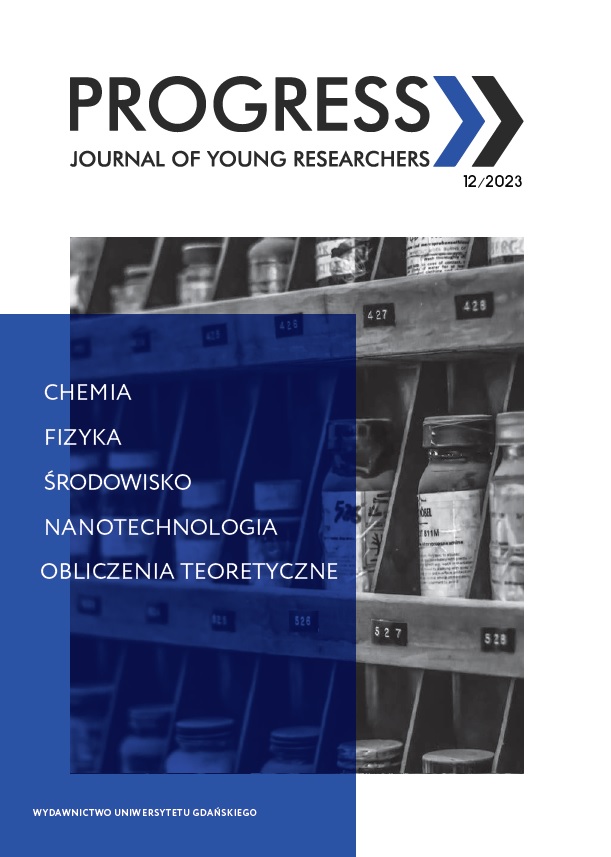Wpływ temperatury na metanolowe analogi lodu międzygwiazdowego
DOI:
https://doi.org/10.26881/prog.2023.12.06Słowa kluczowe:
analogi lodu międzygwiazdowego, metanol, krystalizacja loduAbstrakt
Metanol w postaci lodu jest obiektem badań astrochemicznych od wielu lat. Jako prosty związek organiczny CH3OH jest niezwykle interesujący w zakresie badań nad formowaniem i ewolucją lodu międzygwiezdnego. Wyróżnia się trzy formy stałe metanolu – lód w fazie amorficznej, α-krystalicznej oraz β-krystalicznej. Pomimo wielu badań nad porównaniem właściwości chemicznych metanolu w fazie amorficznej i krystalicznej widoczny jest brak systematycznych badań skupionych na przejściu fazowym. Czynniki takie jak ciśnienie, temperatura czy tempo tworzenia lodu mają wpływ na proces przejścia fazowego. W ramach niniejszych badań rozpatrzono wpływ temperatury na spektroskopię oscylacyjną lodu metanolowego. W części eksperymentalnej wykorzystano przenośną komorę astrochemiczną (PAC) z możliwością kontroli temperatury oraz ciśnienia. Temperatura przejścia fazowego została eksperymentalnie oznaczona jako 103 K. Do analizy struktury badanego lodu wybrano dwa mody oscylacyjne metanolu – rozciągające OH oraz kołyszące w płaszczyźnie CH3. Co więcej, dokonano nanoszenia lodu w wyższych temperaturach, co zaskutkowało otrzymaniem odmiennych właściwości oscylacyjnych w zależności od warunków formowania lodu. Niniejsza praca przedstawia właściwości metanolu w formie lodu w funkcji temperatury w zakresie średniej podczerwieni oraz wskazuje na możliwość wyznaczania historii temperaturowej CH3OH.
Downloads
Bibliografia
Baber A.E., Lawton T.J., Charles E., Sykes H., 2011, Hydrogen-Bonded Networks in Surface-Bound Methanol, “The Journal of Physical Chemistry C”, Vol. 115, https://doi.org/10.1021/jp201465d.
Dempster A.B., Zerbi G., 1971, Lattice Dynamics of Methanol: Hydrogen Bonding and Infrared Absorption, “Journal of Chemical Physics”, Vol. 54, https://doi.org/10.1063/1.1675386.
Dishoeck van E.F., 2017, Astrochemistry: Overview and Challenges, “Proceedings of the International Astronomical Union”, Vol. 13, https://doi.org/10.1017/S1743921317011528. Dounce S.M., Mundy J., Lung Dai H., 2007, Crystallization at the Glass Transition in Supercooled Thin
Films of Methanol, “The Journal of Chemical Physics”, Vol. 126, https://doi.org/10.1063/1.2741506.
Falk M., Whalley E., 2004, Infrared Spectra of Methanol and Deuterated Methanols in Gas, Liquid, and Solid Phases, “The Journal of Chemical Physics”, Vol. 34, https://doi.org/10.1063/1.1701044.
Gálvez Ó., Belén M., Martín-Llórente B., Herrero V.J., Escribano R., 2009, Phases of Solid Methanol, “The Journal of Physical Chemistry A”, Vol. 113, https://doi.org/10.1021/JP810239R.
Garrod R.T., Pauly T., 2011, On The Formation of CO2 and Other Interstellar Ices, “The Astrophysical Journal”, Vol. 735, https://doi.org/10.1088/0004-637X/735/1/15.
Garrod R., Park I.H., Caselli P., Herbst E., 2006, Are Gas-Phase Models of Interstellar Chemistry Tenable? The Case of Methanol, “Faraday Discussions”, Vol. 133, https://doi.org/10.1039/B516202E.
Góbi S., Reva I., Tarczay G., Fausto R., 2020, Amorphous and Crystalline Thioacetamide Ice: Infrared Spectra as a Probe for Temperature and Structure, “Journal of Molecular Structure”, Vol. 1220, https://doi.org/10.1016/J.MOLSTRUC.2020.128719.
Gürtler J., Klaas U., Henning T., Abrahám P., Lemke D., Schreyer K., Lehmann K., 2002, Detection of Solid Ammonia, Methanol, and Methane with ISOPHOT, “Astronomy & Astrophysics”, Vol. 390, https://doi.org/10.1051/0004-6361:20020772.
Herbst E., van Dishoeck E.F., 2009, Complex Organic Interstellar Molecules, “The Annual Review of Astronomy and Astrophysics”, Vol. 47, https://doi.org/10.1146/ANNUREV-ASTRO-082708-101654.
James R., 2019, Systematic Mid-IR And VUV Studies Of Electron Irradiated CO2 :NH3 Interstellar Ice, The Open University.
Luna R., Molpeceres G., Ortigoso J., Satorre M.A., Domingo M., Maté B., 2018, Densities, Infrared Band Strengths, and Optical Constants of Solid Methanol, “Astronomy & Astrophysics”, Vol. 617, https://doi.org/10.1051/0004-6361/201833463.
Mifsud D.V., Hailey P.A., Herczku P., Sulik B., Juhász Z., Kovács S.T.S., Kaňuchová Z., Ioppolo S.,
McCullough R.W., Paripás B., Mason N.J., 2022, Comparative Electron Irradiations of Amorphous and Crystalline Astrophysical Ice Analogues, “Physical Chemistry Chemical Physics”, Vol. 24, https://doi.org/10.1039/D2CP00886F.
Moore M. H., Ferrante R.F., Nuth J.A., 1996, Infrared Spectra of Proton Irradiated Ices Containing
Methanol, “Planetary and Space Science”, Vol. 44, https://doi.org/10.1016/0032-0633(95)00120-4.
Moruzzi G., Winnewisser B.P., Winnewisser M., Mukhopadhyay I., Strumia F., 2018, Microwave, Infrared, and Laser Transitions of Methanol Atlas of Assigned Lines from 0 to 1258 Cm-1’. Microwave, Infrared, and Laser Transitions of Methanol Atlas of Assigned Lines from 0 to 1258 Cm-1, https://doi.org/10.1201/9781351074650. Palumbo, M.E., Castorina A.C., Strazzulla G., 1999, Ion Irradiation Effects on Frozen Methanol (CH 3 OH)’, “Astronomy & Astrophysics”, Vol. 342.
Papoular, R. (2005), On Water Ice Formation in Interstellar Clouds, “Monthly Notices of the Royal Astronomical Society”, Vol. 362, https://doi.org/10.1111/j.1365-2966.2005.09313.x.
Pontoppidan K.M., Dartois E., van Dishoeck E.F., Thi W.F., D’Hendecourt L., 2003, Detection of Abundant
Solid Methanol toward Young Low Mass Stars, “Astronomy & Astrophysics”, Vol. 404, https:// doi.org/10.1051/0004-6361:20030617.
Qasim, D., Chuang K.J., Fedoseev G., Ioppolo S., Boogert A.C.A., Linnartz H., 2018, Formation of Interstellar Methanol Ice Prior to the Heavy CO Freeze-out Stage, “Astronomy & Astrophysics”, Vol. 612, https://doi.org/10.1051/0004-6361/201732355.
Schmidt F., Swiderek P., Bredehöft J.H. (2021), Electron-Induced Processing of Methanol Ice, “ACS Earth and Space Chemistry”, Vol. 5, https://doi.org/10.1021/ACSEARTHSPACECHEM.0C00250.
Torrie B.H., Binbrek O.S., Strauss M., Swainson I.P., 2002, Phase Transitions in Solid Methanol, “Journal of Solid State Chemistry”, Vol. 166, https://doi.org/10.1006/JSSC.2002.9615.
Torrie B.H., Weng S.X., Powell B.M., 1989, Structure of the α-Phase of Solid Methanol, “Molecular Physics”, Vol. 67, https://doi.org/10.1080/00268978900101291.
Whittet D.C.B., Schutte W.A., Tielens A.G.G.M.,Boogert A.C.A., de Graauw T., Ehrenfreund P., Gerakines P.A., Helmich F.P., Prusti T., van Dishoeck E.F., 1996, An ISO SWS View of Interstellar Ices: First Results?, “Astronomy & Astrophysics”, Vol. 315.
Wirström E.S., Geppert W.D., Hjalmarson Å., Persson C.M., Black J.H., Bergman P., Millar T.J., Hamberg,
Vigren E., 2011, Observational Tests of Interstellar Methanol Formation, “Astronomy & Astrophysics”, Vol. 533, https://doi.org/10.1051/0004-6361/201116525.
Pobrania
Opublikowane
Jak cytować
Numer
Dział
Licencja
Prawa autorskie (c) 2023 Author(s)

Utwór dostępny jest na licencji Creative Commons Uznanie autorstwa 4.0 Międzynarodowe.

 Uniwersyteckie Czasopisma Naukowe
Uniwersyteckie Czasopisma Naukowe




